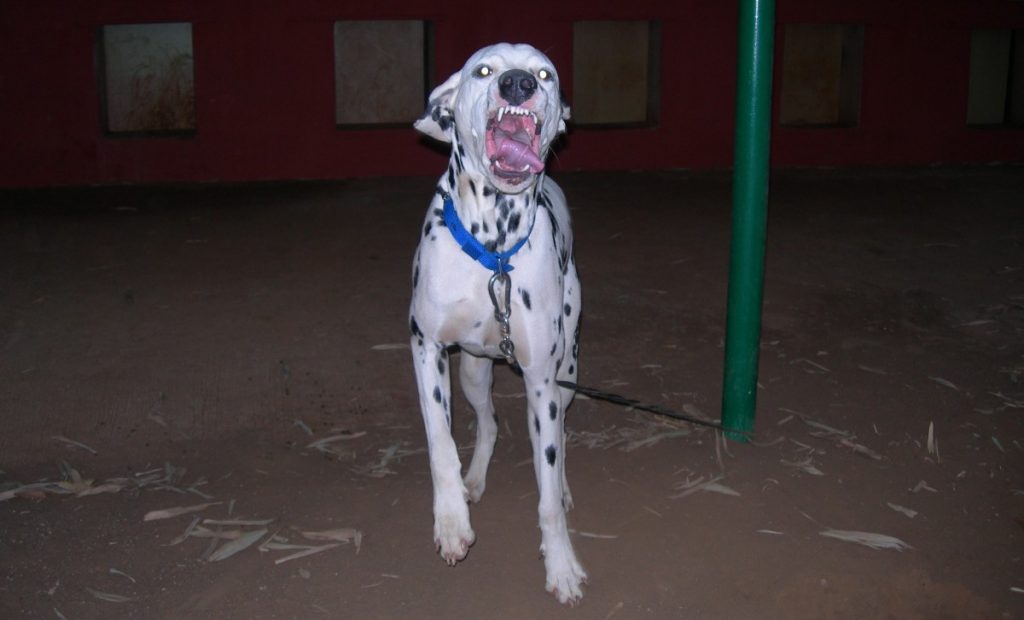Leigh
BAD TV DOG TRAINING ADVICE: 7/9/2009
HI! I’m Leigh, the dog trainer who’s business is Animal Behavior Consulting (and, I also own and run Ruff Customers Dog Training). I am posting for the first time tonight (this post was originally published in July 2009), and I really have a burning issues on my mind. Animal Planet TV network has chosen to air a new dog “training” show, no doubt due to the success of other shows such as “It’s Me or the Dog” with Victoria Stilwell and “Underdog to Wonderdog” which features Andrea Arden. Both shows feature dog-friendly positive reinforcement techniques almost exclusively. However, this new show  features a self-proclaimed dog “trainer” (he also runs his own training school, sadly) called Brad Pattison. The show is a half hour, and it shows him using exclusively punishment based and compulsion reliant dog training, complete with choke chains, yelling, and hanging a dog with it’s front feet off the ground. (the dog was a Boston Terrier, all of 15 lbs I’d guess). His manner is brusque, confrontational, arrogant, disrespectul to both dogs and people, and quite frankly, abusive. I watched two episodes, and I felt nauseated afterward. The violence with which he yanked on the dogs’ choke chains was appalling. I’m sickened.
features a self-proclaimed dog “trainer” (he also runs his own training school, sadly) called Brad Pattison. The show is a half hour, and it shows him using exclusively punishment based and compulsion reliant dog training, complete with choke chains, yelling, and hanging a dog with it’s front feet off the ground. (the dog was a Boston Terrier, all of 15 lbs I’d guess). His manner is brusque, confrontational, arrogant, disrespectul to both dogs and people, and quite frankly, abusive. I watched two episodes, and I felt nauseated afterward. The violence with which he yanked on the dogs’ choke chains was appalling. I’m sickened.
I usually just don’t get all that worked up over these things. Yeah, I don’t like Cesar Millan’s methods, BUT he’s at least right on a couple of fronts. Dogs often need WAYYYYYY more excercise than they’re given by their owners, and he does read dogs’ body language well sometimes. AND, on occasion he does use some positive techniques. He is a terrible trainer, and his idea of rehabilitation hinges on punishing dogs into submission and shutdown. That said, he does love dogs, he’s just completely misguided on how to best teach them, with respect and without fear and pain as his primary tools.
Then there’s the Monks of New Skete show, Divine Canine. It was so boring watching Father You’re-Going-to-Hell-for-Treating-Dogs-this Way that I assume it’s been canceled.
This is what I said in my letter to Animal Planet Customer Relations:
QUOTE:
“In the Doghouse” is the is the most disgusting excuse for dog training show I have witnessed. Brad Pattison is a nightmare for dogs. His techniques are brutal, outdated, not scientifically sound, and quite literally abusive. I cannot believe your network used the poor judgment to air such a throwback show. I know that AP did air some episodes of the Monks of New Skete show divine canine but it was so dull it seemed destined for cancellation. Bad, but not like this show. After choosing to air two good shows with trainers who use modern, scientifically sound training, dog-friendly techniques, i am extremely disappointed in this terrible and detrimental choice. More viewers will attempt these harsh, abusive techniques on dogs with disastrous consequences. I ask you, in the name of dog-friendly training from a true dog lover and professional dog trainer, PLEASE take this show off the air. It is a giant step backward for Animal Planet.
Thank you for reading. — Leigh Sansone, Esq., CPDT
END QUOTE
I hope you’ll join me in roundly chastising Animal Planet for such a HORRIBLE decision — this show, if it’s watched, will set dog training back ANOTHER 20 years (Millan started that trend).
Peace!
Leigh, who is currently “Sick in the City” over this show
(7/9/2009)
DetailsLA TIMES ARTICLE ON CANINE DISARMING – AWFUL
Check out this article where the writer basically has had her dog’s teeth removed in order to solve biting issues. NOT ADDRESSING the problems, no, that would be HARD. Egads!! this is insane.

READ ON if you dare….
from : LOS ANGELES TIMES
PETS
When ‘Dog Whisperer’ can’t help
Cotton
(Email Picture)
Brian Vander Brug / Los Angeles Times
How had the 35-pound bouncing ball of fluff become a public menace? Krieger says it wasn’t apathy on her part. She enrolled Cotton in puppy classes and basic training at the neighborhood PetSmart. She bought a library of self-help books and videos. Nothing worked.
Not even Cesar Millan’s ‘idiot-simple’ method could ease Cotton’s biting problem. At wit’s end, his family turns to the controversial procedure ‘canine disarming.’
By Diane R. Krieger
July 25, 2009
“The Kriegers have not been able to successfully implement Cesar’s technique.”
There it is in black and white for all to see, on page 299 of the Dog Whisperer’s “Ultimate Episode Guide.” The sad truth. Our episode (titled “Raw Cotton”) first aired more than two years ago. To this day, whenever I see a rerun, I cringe at the closing scene: me, boasting about Cesar Millan’s method being “idiot simple.”
FOR THE RECORD:
Dog disarming: In Saturday’s Home section, an article about dogs that bite said Dr. Gail Golab led the American Veterinary Medical Assn. She is director of its animal welfare division. —
Cotton — our beloved, 6-year-old American Eskimo — is still a biter. I suppose he will always be a biter. And, as my lawyer husband keeps reminding me, “a lawsuit waiting to happen.” Not that his bites are so powerful: I once had a cat who left comparable fang marks. But the cat didn’t lunge at visitors.
How had the 35-pound, bouncing ball of fluff that is our family pet become a public menace? It sure wasn’t through apathy on my part. I had tried everything. Puppy classes and basic-training at the neighborhood PetSmart. A library of self-help books and videos. Even a pricey dog-aggression expert whose Israeli accent made me want to stand at attention. He ordered counter-conditioning and desensitization drills, supplemented by a low-protein diet and a doggie herbal remedy akin to St. John’s Wort.
Nothing worked.
I tried clicker training, high-pitched electronic tones, pepper spray, throwing soda cans filled with rocks. I considered an electric shock collar but worried that in the hands of an amateur (that would be me, the aforementioned idiot) it might do more harm than good.
Finally, I appealed to the fabled Dog Whisperer.
Cesar’s efforts were a brilliant success — until he left our house. For one day, Cotton was the dog I’d always dreamed he could be. Calm and submissive, deferring to the pack leader. Unfortunately, the pack leader was Cesar.
Reluctantly, I looked into shipping Cotton to a dog rescue — but didn’t find one that would take a dog with a history of biting. No chance of ever placing him with a new owner, they explained. Unacceptable liability. Months later, I had a follow-up visit with Cesar at his Dog Psychology Center in South L.A. Surrounded by his spectacularly submissive pack, he accepted my lack of leadership skill and suggested I try a full-time muzzle. I had already tried that and concluded the restraint has yet to be invented that Cotton couldn’t wriggle out of.
I considered defanging him, but couldn’t find a vet in the area who would do it. Turns out the practice is both unsafe and impractical. To extract a dog’s mighty canines would likely lead to a fractured jaw. Even if it didn’t, with the canines out of the way, the pointy incisors would be primed to fill the gap.
The only other option seemed to be a lethal injection.
Procrastinating about that difficult decision, I told myself I could avoid future incidents through eternal vigilance. Cotton is protective and territorial: He reserves his animosity for strangers (especially men) who venture up our long, steep driveway. Living on an acre in rustic Rolling Hills Estates, fronted by a country road without sidewalks, with Cotton hemmed in by an invisible fence and crated in the garage whenever company is expected, we should have been able to keep trouble at bay. But trouble kept showing up unexpectedly. There was the time the sheriff’s deputy drove up to alert us to a nearby brush fire: For his thoughtfulness, he received torn pants and teeth marks in his shin. Or the time a furniture delivery guy arrived early: He escaped Cotton’s toothy embrace only by leaping on the hood of his van. Heck, Cotton even slipped his leash and bit the Times photographer who came to take his picture for this article.
But by then, I had a new plan.
One day while channel surfing, I happened upon an Animal Planet special counting down the world’s top 10 “extreme biters.” The domesticated dog came in at No. 4. (Hippos and Komodo dragons took the No. 3 and No. 2 spots, with the cookie-cutter shark the undisputed champion.) There, to my delight, was Dr. David Nielsen, a veterinary dentist based in Manhattan Beach, talking about a miracle fix: “canine disarming.”
Instead of extracting the four canines, Nielsen cuts away 4 millimeters of tooth using a CO2 laser. He acid-etches the live pulp within, fashions a bell-shaped cavity that he packs with two kinds of human-grade composite, and light-cures the top for a smooth, flat finish. He also blunts the extra set of pointy incisors.
Disarming isn’t a new idea, but Nielsen’s technique is one he pioneered, though he shares credit with his now-departed pet whippet. The small greyhound had “played Frisbee so much and chewed so hard trying to get out of cages” that he’d busted off all four canines right above the 4-millimeter level, Nielsen says. One day the whippet cornered a technician in Nielsen’s office and flew at her face. Instead of tearing flesh, he merely pinched her cheek. The blunted canines blocked even the incisors from their shearing action.
A metaphorical light bulb came on above Nielsen’s head.Now he figures he has disarmed some 300 animals in the last dozen years, not all of them dogs. A short while ago, he treated a kitty whose love bites had turned a little too intense. He’s also used the procedure, for various reasons, on wolves and a tiger.
Nielsen may be something of a maverick. Dr. Gail Golab, head of the American Veterinary Medical Assn., says that disarming dogs was once fairly common, but that it fell out of favor several years ago as behavioral modification techniques improved. The association is opposed to either tooth removal or disarming, primarily on the grounds that neither addresses the underlying cause of aggression and may lull owners into a false confidence that the animal can no longer inflict injury.
The American Veterinary Dental College agrees that disarming is controversial, but in a position statement adopted in 2005 it endorsed the procedure in “selected cases.”
In June, I signed Cotton up. It would cost a pretty penny: $1,600. But it’s easy to see why. Nielsen uses state-of-the-art human dental and surgical techniques. Cotton would be sedated before full intubation under general anesthesia. He would receive an IV drip of fluid potassium, and technicians would hook him up to a battery of machines monitoring his oxygen level, heart rate and blood pressure. The doctor would consult digital X-rays taken just before the procedure and track his progress with more X-rays along the way. Cotton would get deep scaling before the procedure and a foamy fluoride treatment after. And he would go home with enough antibiotics and pain relievers to last a week. Once he recovered from the surgery, there would be no lasting side effects: Cotton would be able to eat, chew and play normally.
For all the technology, Nielsen says the most profound effect of canine disarming is psychological. “You can see it in their eyes almost the moment they wake up from the anesthesia,” he says. “It’s like they’re wondering, ‘who took away my knives?’ ” An epiphany that humbles and subdues them for all time. The Bumble from “Rudolph, the Red-Nosed Reindeer” comes to mind. Remember how sweet the ferocious yeti becomes after Hermey, the misfit elf-turned-dentist, does his handiwork?
On the day of Cotton’s treatment, another dog — a 5-year-old pit bull named Jesse — was also disarmed. Jesse has issues with things that ring. Woe betide anyone who picks up the phone, answers the door or holds a beeping camera in Jesse’s presence. Mallory Hartt, 55, of San Pedro, her sons and even their other dog, a Patterdale terrier, all have scars to show for Jesse’s peculiar mania.
After the disarming, Jesse was a changed dog. “He just started being silly,” Hartt says. “He would jump around like a bunny rabbit. Like he was happy.” He hasn’t gotten over his ring fetish, and there’s already been “a little scuffle” with the terrier. But the important thing, she says, is that the smaller dog emerged from the fray unscathed.
Lynn Morrison, 52, is no less pleased. Morrison had Nielsen disarm Chrissie, one of her five German shepherds, in March after continuing problems that culminated in a trip to the emergency room for her housemate, Judy Johnson, to repair a badly torn calf. “If it wasn’t for Dr. Nielsen,” says Morrison, “we would have had to euthanize Chrissie, without a doubt.”
As for Cotton, he seems to be in denial. When he gets the opportunity, he still pounces at any man who ventures onto our property. A few days after the disarming, our gardener Guadalupe Davila obligingly offered his booted foot for Cotton’s delectation. After 30 seconds of ferocious gnawing, Cotton had only succeeded in lightly scoring the thick leather.
The next day, when Cotton bolted out the door to discover handyman Julio Miranda building a new handrail, he grabbed a mouthful of cedar post. After some unbridled gnawing, he only lightly scored the soft wood.
Cotton has yet to actually chomp on human flesh. If he does, we fervently hope the epiphany Nielsen described will finally take hold. Come to think of it, Cotton does sort of resemble the Bumble.
(Originally published by Ruff Customers Dog Training. Copyright 2009. : 7/30/2009)
- BAD TV DOG TRAINING ADVICE: 7/9/2009
- LA TIMES ARTICLE ON CANINE DISARMING – AWFUL
- DON’T WHISPER AT YOUR PUPPY!! TRY POSITIVE REINFORCEMENT
- Hello world!
DON’T WHISPER AT YOUR PUPPY!! TRY POSITIVE REINFORCEMENT
In the NY Times on July 22, an article appeared on the authors’ getting a golden retriever pup it promises to be a weekly series chronicling the pup’s misadventures. The troubling parts for many positive reinforcement dog trainers is that she only mentioned Cesar Millan and the Monks of New Skete. BOTH of these “trainers” rely on punishment based methods including physical force. This reader below commented strongly in support of positive training. 
See post–
Caroline F.
SoutheastPA
July 21st, 2009
8:25 am
Please consider adding the materials below to your reading lists / references for talking to readers of the NYTimes.
My heart sinks to see the Dog Whisperer and the Monks listed as the main go-to references for raising and training a puppy. So many people have taken away the message that confrontation, force and aggressive dominance displays are necessary, and so many of these people have unwittingly created problems with harsh and / or inappropriately applied training techniques, often used unskillfully as well.
I’m not suggesting that you and your husband are unskillful or doing wrong by your puppy. There are people and dogs who do just fine using the references you mentioned. However, there are also many, many people who do not and who wind up frustrated or in trouble. They don’t realize that there are many vets, behaviorists and trainers with different information.
Critics often pan reward-based or relationship based training as cookie pushing, permissive or wishy-washy, but this is a straw man argument. There are unskilled trainers of all types. The skilled veterinary behaviorists and trainers arguing against the methodologies and rationales of Cesar Millan and the Monks of New Skete are well aware that training a dog will involve the ability to set boundaries and rules in a fair and consistent manner and understand that permissiveness and the lack of clear communication can lead to problems. (Not to mention meeting the dogs’ needs for exercise, mental stimulation and environmental enrichment.)
How I wish that broad and deep dog knowledge, including the ability to read subtle body language, science (animal behavior, physiology, ethology, operant conditioning, for example) as well as experience and savvy figured in the version of dog training that most people absorb from the popular press.
Thanks for your consideration; some references below!
Dr. Ian Dunbar
http://www.dogstardaily.com/
http://www.siriuspup.com…
http://dogtime.com…
http://www.ted.com…
Suzanne Clothier
http://flyingdogpress.com/
The articles are well worth signing up to access.
Dr. Patricia McConnell
Dr. Nicholas Dodman
http://www.tufts.edu…
AVSAB position statements on punishment, dominance, puppy socialization – pdfs
http://www.avsabonline.org…
JAVMA News – precis of AVSAB position paper on punishment
http://www.avma.org…
David Mech on alpha (change in use by wolf biologists) – pdf
Vet Study: If You’re Aggressive Your Dog Will Be Too
http://www.sciencedaily.com
Originally published by Ruff Customers Dog Training. Copyright 2009. : 8/1/2009
- BAD TV DOG TRAINING ADVICE: 7/9/2009
- LA TIMES ARTICLE ON CANINE DISARMING – AWFUL
- DON’T WHISPER AT YOUR PUPPY!! TRY POSITIVE REINFORCEMENT
- Hello world!
Hello world!
Welcome to WordPress. This is your first post. Edit or delete it, then start writing!
Details